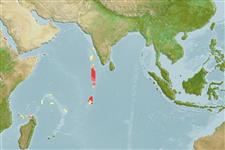Classification / Names
Noms communs | Synonymes | Catalog of Fishes(Genre, Espèce) | ITIS | CoL | WoRMS | Cloffa
>
Eupercaria/misc (Various families in series Eupercaria) >
Labridae (Wrasses) > Corinae
Etymology: Coris: Greek, kore, -es = pupil and also with themenaing of "maid" (Ref. 45335); latifasciata: Name from the Latin, referring to the broad dark bars dorsally on the body (Ref. 93522).
Environment: milieu / climate zone / depth range / distribution range
Écologie
marin récifal; profondeur 10 - 28 m (Ref. 93522). Tropical
Indian Ocean: Maldive Islands and Chagos Archipelago.
Taille / Poids / Âge
Maturity: Lm ? range ? - ? cm
Max length : 9.4 cm SL mâle / non sexé; (Ref. 93522)
Description synthétique
Morphologie | Morphométrie
Épines dorsales (Total): 9; Rayons mous dorsaux (Total): 11; Épines anales 3; Rayons mous anaux: 11. This species is distinguished by the following characters: D IX,11; A III,11; pectoral rays 14 (rarely 15); lateral-line scales 50-52 (+1); scaleless head; gill rakers 19-22; a pair of large, strongly projecting, slightly recurved canine teeth anteriorly in each jaw, the upper pair slightly out-flaring, the lowers fitting between uppers when mouth closed; body depth 3.25-3.55 in SL; caudal fin truncate to slightly rounded; short pelvic fins, 1.4-1.6 in head length; body colour of adults pale blue to blue-green, the scale centers whitish, especially on abdomen, 6 dusky orange bars dorsally on body, much broader than whitish interspaces, 2 small bars on nape; broadest bar below fourth to eighth dorsal spines, curving posteriorly in its lower part; head pale green with oblique pink bands; an ocellated black spot between first and second soft rays of dorsal fin; a black spot at upper base of pectoral fin, continuing as a narrowing line across base; juveniles light blue-green with scattered small red spots, larger and more numerous on postorbital head and anterior body; a second smaller ocellus posteriorly in dorsal fin; a blackish stripe on side of snout (Ref. 93522).
Life cycle and mating behavior
Maturité | Reproduction | Frai | Œufs | Fécondité | Larves
Oviparous, with distinct pairing during breeding (Ref. 205).
Randall, J.E., 2013. Seven new species of labrid fishes (Coris, Iniistius, Macropharyngodon, Novaculops, and Pteragogus) from the Western Indian Ocean. J. Ocean Sci. Found. 7:1-43. (Ref. 93522)
Statut dans la liste rouge de l'IUCN (Ref. 130435)
Menace pour l'homme
Harmless
Utilisations par l'homme
Pêcheries:
Plus d'informations
Noms communsSynonymesMétabolismePrédateursÉcotoxicologieReproductionMaturitéFraiRassemblement de ponteFéconditéŒufsDéveloppement de l'œuf
Taille/ÂgeCroissanceLongueur-poidsLongueur-longueurFréquences de longueursMorphométrieMorphologieLarvesDynamique des populations larvairesRecrutementAbondanceBRUVS
RéférencesAquacultureProfil d'aquacultureSouchesGénétiqueElectrophoresesHéritabilitéPathologiesTraitementNutrientsMass conversion
CollaborateursImagesStamps, Coins Misc.SonsCiguateraVitesseType de nageSurface branchialeOtolithesCerveauxVision
Outils
Articles particuliers
Télécharger en XML
Sources Internet
Estimates based on models
Preferred temperature (Ref.
123201): 27.4 - 28.1, mean 27.8 °C (based on 6 cells).
Phylogenetic diversity index (Ref.
82804): PD
50 = 0.5000 [Uniqueness, from 0.5 = low to 2.0 = high].
Bayesian length-weight: a=0.00977 (0.00470 - 0.02030), b=3.07 (2.89 - 3.25), in cm total length, based on LWR estimates for this (Sub)family-body shape (Ref.
93245).
Niveau trophique (Ref.
69278): 3.3 ±0.3 se; based on size and trophs of closest relatives
Résilience (Ref.
120179): Haut, temps minimum de doublement de population inférieur à 15 mois (Preliminary K or Fecundity.).
Fishing Vulnerability (Ref.
59153): Low vulnerability (10 of 100).
